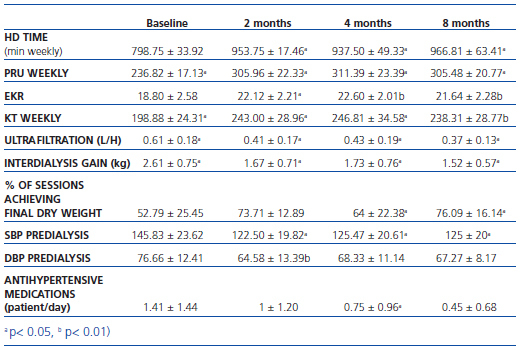Dear Editor,
Over the past few years, there have been many publications on daily haemodialysis that reflect the benefits of increased frequency, especially in terms of cardiovascular health and blood pressure control.1-3 However, in clinical practice we often come up against enormous reluctance from patients when faced with this dialysis technique, since they see it as a worsening of their quality of life by having to go to the dialysis unit every day.4,5 This is further complicated in health regions such as ours (Segovia) where 50% of the population lives in villages, and at times must travel more than an hour.
In this regard, an increased dialysis frequency of four days could result in some cardiovascular benefit with greater acceptance from daily haemodialysis patients.
We present data from 12 patients in our unit who changed to the four weekly session regimen from 2006 to 2008 and were followed for 8 months. The mean age was 67.5 years, mean arterial blood flow was 354.16ml/min and dialysis bath flow was 666.67ml/min. Non-parametric tests were used for data analysis.
The increased frequency allowed for a significant increase in dialysis time from 798.75 to 966.81 minutes per week. In analysing the dialysis dose, both the Casino and López’s EKR (18.8 versus 21.64), the weekly PRU (236.82 versus 305.48), and weekly KT (198.88 compared to 238.31L) showed an increase in the dialysis dose received. Interdialytic gains decreased significantly (2.61 versus 1.52kg) as well as average hourly ultrafiltration during the session (600 versus 375ml). Similarly, the dry weight was achieved at the end of the sessions (with a margin of ± 300mg) more frequently (52.79 compared to 76.09%). The predialysis blood pressure values decreased significantly (145.83/76.66 versus 125.01/67.27) as did the post-dialysis values, albeit to a lesser extent (135.41/73.75 versus 119.98/65.90), and the number of antihypertensive drugs decreased (1.41 versus 0.45) (Table 1). No differences in the number of episodes of hypotension or intradialytic cramping were seen, or in the values of albumin, cholesterol, calcium, phosphorus, CRP, nPCR, dry weight, or the use of phosphate binders.
To conclude, increasing the frequency to 4 weekly sessions allowed us to increase the weekly time and, as a result, the dose of dialysis received. Blood pressure was better controlled and fewer medications were needed. Interdialytic gains were significantly reduced, as was ultrafiltration time, and the prescribed dry weight was more easily achieved. Thus, the patients who can most benefit from the increase to 4 weekly sessions are those with uncontrolled hypertension, excessive interdialytic gains, or who require a higher dose of dialysis.
Table 1. Haemodynamic parameters and dialysis dose in those patients in whom variation was seen when going from the 3 sessions weekly regimen to 4 sessions weekly regimen







